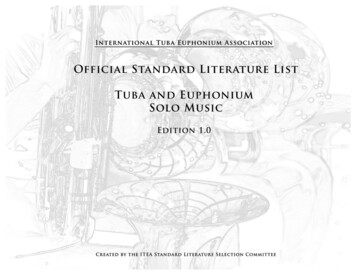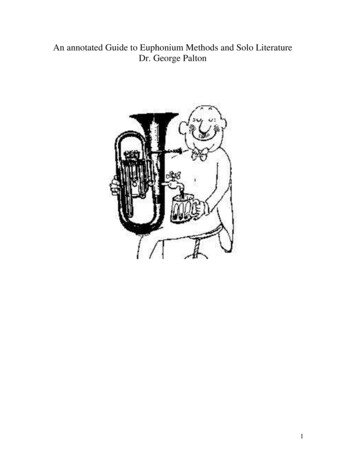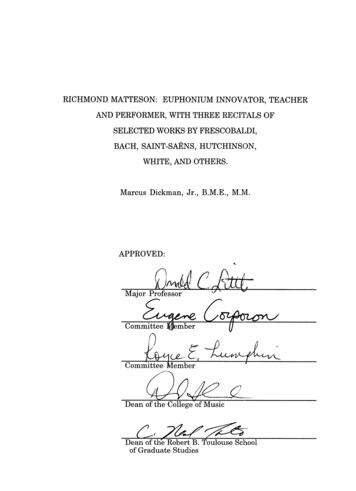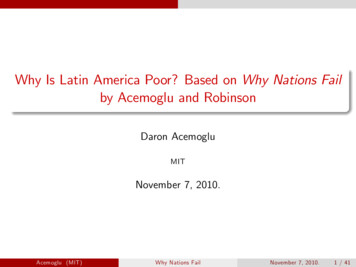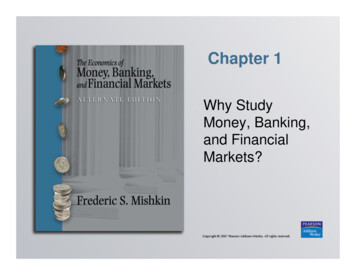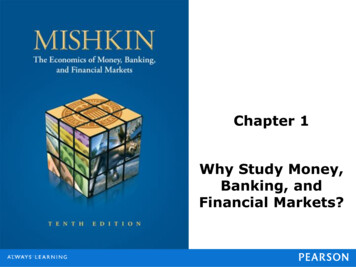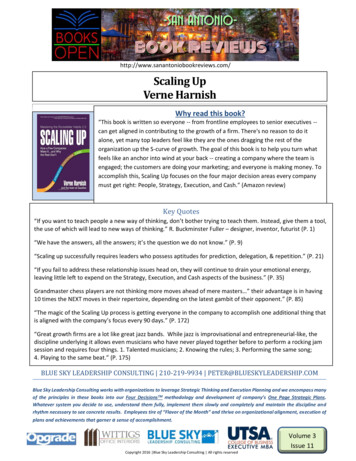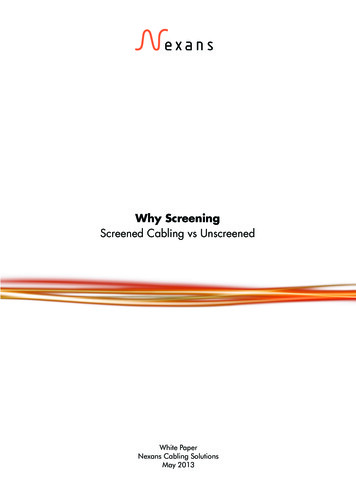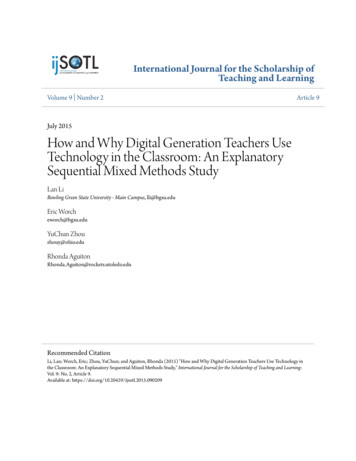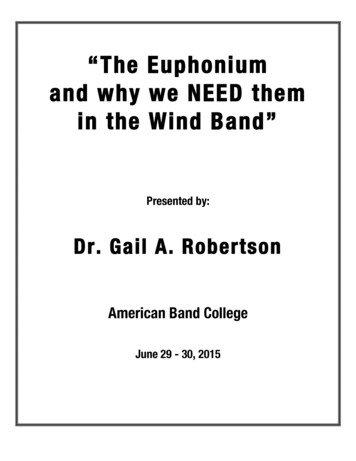
Transcription
“The Euphoniumand why we NEED themin the Wind Band”Presented by:Dr. Gail A. RobertsonAmerican Band CollegeJune 29 - 30, 2015
2Why your band needs the euphonium: It has a conical bore that produces a “rich and dark” tone thatprovides a foundation for the trombones, tubas, and lower woodwinds; the euphonium is one of the most versatileinstruements in the band “the cello of the wind band.”A little bit of history: Just prior to the development of the wind band, the euphonium was introduced in 1843by Sommer (Weimar). By 1854, the euphonium and baritone horn had established a leading role in the militarybands and brass bands of Europe. In 1872, the euphonium became a standard member of the American wind bandwhen Gilmore employed two euphoniumists in his band.The cello of the wind band: During what is known as the “Golden Age of Bands,” the role of the euphoniumsoared. Since most of the early works for band were orchestral transcriptions, the cello part needed a home. Due tothe euphonium’s deep, rich, and mellow tone, it was the likely choice to assume this role. Sousa also utilized theeuphonium as the standard tenor‐voice instrument and also hired two euphoniums in his band.A few outstanding descriptions of the role of the euphonium:Prof. H. KlingModern Orchestrationand Instrumentation(1902)“The employment of thisbeautiful instrument, whichcan be fittingly compared withthe voice of a baritone singer,is similar to the use of theViolincello in the orchestra. Itstone can always be plainlydistinguished from among thegreatest mass of instruments.”
3Mayhew L. LakeThe American BandArranger (1920)“The BARITONE is the most usefulinstrument in the Band, in fact thevarious ways and means of employingit are so numerous that it wouldrequire a small volume to enumeratethem all. The smooth tone of thisinstrument penetrates through theentire ensemble and as a melodyinstrument it is superb. Owing to itssympathetic and smooth tonal qualityit is frequently alluded to as “the Celloof the Band.”Clair Johnson’s Outstanding Descriptionof the Euphonium and Its Role!! “TheBaritone: In this instrument the arranger finds one of themost versatile and useful of the band. It is adaptable to a greatnumber of roles and capable of giving a good account of itself,whether assigned to the melody, a tenor countermelody, or thebaritone voice. Its voice blends well with the lower woodwinds orwith the brasses. In technical facility the baritone ranks as anear equal to the cornet. The baritone enjoys a degree ofindependence by not being a member of a section, as is thecase with cornets, horns, and trombones. It can join with them,or go its way alone.”From: Practical Scoring for the Concert Band, Clair Johnson (1961).
go4How the Euphonium “chose” me:Standard Wind Band music that has great euphonium parts:March, “The Stars and Stripes Forever” (Sousa)1. Pomp and Circumstance – Sir Edward Elgar2. Procession of the– Rimsky‐Korsakovh Nobles1203. Suite in F – Gustav œHolst.œ œ 4. CommandoBarber? b b CMarch – SamualJœ b œ n œ œ n œ œ Œ . œ .b5. Festive Overture– Dmitri Shostakovich/Donald Hunsbergerƒ6. Everythingwrittenby John Philip Sousa!j. ƒ ? bb b? bbb? bbbœ n œ œ. œ. œ b œ œœœ. œœ œ. œœ Œœ.œœ œ œœ œ . œ œ œ . œ œ œ . œ œ . œ œ n œ œ. œ œ œ n . œ b œ. œ. œJ œJ. œ. n œ. œ. œ.œ œJ‰‰J ‰‰ J‰ J‰J‰J‰p.œ 1.2. . . .œ ‰ œ œ œ œ ‰ œ œ œ œJ ‰ ‰ œJ J ‰ ‰ œJ œJ ‰ n œJ ‰ Jœ ‰ b œJ. ‰ œ ‰ n œ œ œ œ œ œ Œ . œ Œ œ . œJJ nœ œ J nœ œJfpff œ . œ œ . œ. œ œ œ. œ J w œ . œJ œ œJ J Jƒœ. œ œœœJ œ œ . œJ w œ Œ ÓGustavHolst – Suite in F (1911)? bbbMarch from Suite in F for Military Band, Opus 28, No. 2 (Holst)h 120? b 22 Ó œ . œJ w F . œ . œ œ. œ JEsolo? bœ œ œ œ? b w? bw œ. œ JF . œ . œ . œ œJ œ œ œ œ . œ œ œ œ œ wcresc.2œ œ œ œ w USMB Euphonium Audition Excerpts
5John Philip Sousa (1854 – 1932)Sousa played: Violin, Voice, Piano, Flute, Cornet,Baritone Horn, Trombone, and Alto HornThe Invincible Eagle (1901)Bullets and Bayonets (1919)Reasons why students should play the Euphonium:A. Middle/Jr. High and High School Band: (You can rent a school instrument; not as many people play it.There’s not as much competition so players are more laid back).B. College/University Band: (Scholarship opportunities are often greater and there can be lesscompetition).C. Post college opportunities: (Community Bands, British Brass Bands, and churches).D. Unique Euphonium related events that occur every year: (TUBACHRISTMAS and OCTUBAFEST).E. Professional Perfoming Positions: (Military Bands, Theme Parks, Brass Bands, and Concert Bands).Reasons why new students don’t pick the euphonium and why we are sometimes “bored” in band:A. Lack of quality school instruments. (Who wants to play a beat up horn?).B. Lack of challenge in the band sheet music. (Nothing to practice and there is only one euphonium part).C.D.E.F.G.*see attached exampleLack of attention. (We sit in the back).Lack of visibility. (Not found on MTV and in Pop Music).Lack of posters and pictures of professional players.The euphonium is not a full‐time instrument in the Jazz Band or Orchestra.Lack of quality instruments, CD’s, and sheet music to select from in local music stores.
6
7
8Suggested solos for students to use at Solo and Ensemble Festivals:Solos that are Best for 6th Graders: (1st year players)Air NobleConquerorHappy SongPied PiperThe RoosterJacques RobertLeonard B. Smith/Leonard FalconeEdmund J. SiennickiForrest L. BuchtelEdmund J. SiennickiSolos that are best for 7th graders:In the Hall of the Mountain KingMinuet in GMinstrel BoyPolovetsian DancesSparklesThe Young PrinceEdvard Grieg/G. E. HolmesJ.S. Bach/Ronald C. DishingerForrest L. BuchtelAlexander Borodin/Forrest L. BuchtelFloyd O. HarrisFloyd O. HarrisSolos that are Best for 8th Graders:Asleep in the DeepBrass BanglesCarnival of VeniceEvening in the countryHonor and ArmsThe Jolly PeasantMarch of the MarionetteOcean BeachPavane Pour Infante DéfunteRed CanyonsToreador’s Song form CarmenHenry W. Petrie/Harold L. WaltersFloyd O. HarrisHenry W. DavisBela Bartok/Floyd O. HarrisFrederick Handel/Allen OstranderRobert Schumann/G. E. HolmesCharles Gounod/Harold L. WaltersFloyd O. HarrisMaurice Ravel/Ronald DishingerClair W. JohnsonGeorges Bizet/G. E. HolmesSolos that are Best for advanced 8th graders and 9th Graders:Arioso (From Cantata No. 156)Concert AriaConcert Rondo (k. 371)Fancy FreeFantasy for TromboneMirror LakeMy RegardsPrelude and MinuetRhapsody for EuphoniumRondoRomanzeThe Bride of the WavesTramp, Tramp, TrampJohann Sebastian Bach/H.R. KentW. A. Mozart/H. VoxmanW. A. Mozart/Jay ErnstClay SmithJames CurnowEdward MontgomeryEdward LlewellynArcangelo Corelli/Richard E. PowellJames CurnowW. A. Mozart/Ronald DishingerGustav CordsHerbert L. ClarkeEdwin Franko Goldman/Theo M. Tobani
9Solos that are Best for10thand11thgraders:Allegro SpiritosoAndante et AllegroAndante and RondoAnnie LaurieBeautiful ColoradoCarnival of VeniceConcerto (for Trombone)Concerto Rondo (Bassoon concerto mvt. 3)Dance Suite (Unaccompanied)Grand ConcertoIntroduction and DancePhantasy Piece Op. 10, #2Minuet‐ ScherzoRomanza AppassionataScene De ConcertSolo De ConcoursSonata (any one)Sonata in F majorSonata in F minorSuite for BaritoneToccata in the Style of FrescobaldiStarlight (Waltz Caprice)Variations on a Theme of Robert SchumannJean Baptiste Senaille/Leonard FalconeJ. Ed. BaratAntonio Capuzzi/Philip CatelinetArthur Pryor/Robert GeislerJoseph De LucaHerbert L. Clarke/Arthur BrandenburgNikolai Rimsky‐KorsakovW. A. Mozart/Richard FoteBrian IsrealFriedebald GrafeJ. Ed. Barat/Glenn SmithBurnet TuthillJoseph De LucaCarl Maria von Weber/P. X. LaubeMax F. DenmarkPaul Veronge de la NuxJohann Ernst Galliard/Karl Heinz Fussl/Keith BrownBenedetto Marcello/Allen OstranderGeorg Philipp Telemann/Allen OstranderDon HaddadGaspar Cassado/Keith Brown (tenor clef)Arthur PryorRobert Schumann/William DavisSolos that are Best for advanced 12 graders and college students:Allegro et FinaleAndante et AllegroBelieve me, If All those Endearing Young CharmsBlue Bells of ScotlandCarnival of VeniceConcert FantasieConcertino Op. 4Concertino #1 in B flat MajorConcerto Mvt. 1 (K. 191 for Bassoon)Euphonium ConcertoFantasiaFantasia di ConcertoIntroduction and PolonaiseLyric SuiteMorceau Symphonique, Op. 88PantomimeRicercare #1 (Unaccompanied)Sonata for EuphoniumSonata in C MajorSymphonic VariantsEugéne BozzaJ. Guy Ropartz/A. ShapiroSimone Mantia/David WerdenArthur PryorJ. B. Arban/Edwin Franko GoldmanGustav CordsFerdinand DavidJulius Klengel/Leonard FalconeW. A. Mozart/Allen OstranderJoseph HorovitzGordon JacobEdoardo BoccalariMax DenmarkDonald H. WhiteAlexandre Guilmant/E. FalaguerraPhillip SparkeAndrea GabrieliDavid UberJohann Friedrich Fasch/FrommeJames Curnow
10Suggested solos for euphonium soloist and Band:Andante et AllegroBelieve me, If All those Endearing Young CharmsBlue Bells of ScotlandBeautiful ColoradoCarnival of VeniceDanny BoyFantasiaFantasia di ConcertoFantasy for TromboneIntroduction and DanceMirror LakeMorceau Symphonique, Op. 88My RegardsNapoliRhapsody for EuphoniumSymphonic VariantsThe Bride of the WavesJ. Ed. Barat/Loren MarstellerSimone Mantia/David WerdenArthur Pryor/PearsonJoseph De LucaHerbert L. ClarkeTraditional/Lewis BuckleyGordon JacobEdoardo BoccalariJames CurnowJ. Ed. BaratEdward MontgomeryAlexandre Guilmant/ShepardEdward LlewellynHerman BellstedtJames CurnowJames CurnowHerbert L. Clarke
!"!11Suggested Solos for Euphonium AuditionsAllegro SpiritosoAndante et AllegroAndante and RondoBlue Bells of ScotlandThe Bride of the WavesConcertino Op. 4Euphonium Concerto (mvt. 1)FantasiaFantasia di ConcertoGrand ConcertoIntroduction and DanceMorceau Symphonique, Op. 88Rhapsody for EuphoniumSonata in F major (two contrasting movements)Sonata in F minor (two contrasting movements)Suite for BaritoneVariations on a Theme of Robert SchumannJean Baptiste Senaille/Leonard FalconeJ. E. BaratAntonio Capuzzi/Philip CatelinetArthur PryorHerbert L. ClarkeFerdinand DavidJoseph HorovitzGordon JacobEdoardo BoccalariFriedebald GräfeJ. Ed. Barat/Glenn SmithAlexandre Guilmant/E. FalaguerraJames CurnowBenedetto Marcello/Allen OstranderGeorg Philipp Telemann/Allen OstranderDon HaddadRobert Schumann/William Davis!!"# %&'!()%* ,-) !(./'0%12!3 0!4)5-1- ,26!!# %&!!"# %&'() *( ),-(.!'(!)* ,% !-* ./%01234 35*6!!!
!!!!!!!12"!!!
!!13"!!"# %&'() * ,-)#'(.)/&0'1 2'3)/-.- ,04''!
!14"!
15Dr. Gail Robertson earned her B.A. degree from the University of Central Florida and a M.M. inEuphonium Performance from Indiana University while serving as graduate assistant to Harvey Phillips.She postponed her doctoral studies at the University of Maryland with Dr. Brian Bowman to perform withthe “Tubafours” at Walt Disney World, Orlando where she served as musical supervisor/chief arrangerand produced a highly acclaimed CD, “Tubas Under the Boardwalk.” She has recently completed her D.M.A.as a University Distinguished Fellow at Michigan State University studying with Phil Sinder, Ava Ordman,and Ricardo Lorenz. She has taught on the faculties of Eastern Michigan University, the University ofCentral Florida, Bethune‐Cookman University, the University of Florida, Valencia, and SeminoleCommunity Colleges, and remains active as a teacher, adjudicator, composer, arranger and free‐lanceartist, both nationally and internationally.Robertson currently serves as Visiting Assistant Professor of Tuba and Euphonium/Jazz at the Universityof Central Arkansas where she is tubist in the Pinnacle Brass and teaches the Jazz Ensemble II. She isthe Chair/Chief Editor of the International Tuba and Euphonium Press, and serves on the Board ofDirectors of the Leonard Falcone Tuba and Euphonium Festival, the International Tuba and EuphoniumAssociation (ITEA), and the International Women’s Brass Conference (IWBC). She has served as Presidentof the IWBC and as a conference host in 2010 and 2006. She has also served as Euphonium andMembership Coordinator of the International Tuba and Euphonium Association (ITEA) and was thefeatured artist on the cover of the ITEA Journal (Vol. 38:1, Fall 2010). Two of Gail’s original works havealso been featured Gems in the ITEA Journal (Jazz Encounter No. 1 ‐ Gem Series No. 22, Vol. 38:1, Fall2010, and Allegro et Andantango ‐ Gem Series No. 33, Vol. 41:3, Spring 2014).Gail was recently awarded the 2014 Clifford Bevan Award for Excellence in Research for herdocument, “Restoring the Euphonium’s Legacy as Cello of the Wind Band.” Her original work for brassquintet, Tower Guard Tribute, was awarded honorable mention by the 2014 International Alliance forWomen in Music’s Patsy Lu competition. In May 2009, Gail recorded a new CD with Dr. Stacy Baker, AlexThio, and Dr. Deb Eastwood, called “SymbiosisDuo.” SYMBIOSISDUO released their second CD,“Playground,” in February 2015. Several of the works recorded by the duo were newly commissionedworks written especially for the duo. Composers include: Franz Cibulka, Jim Self, James Grant,Christopher Marshall, Brian Balmages, Chris Sharp, Kimberly Archer, T.O. Sterrett, and Phillip Bimstein.In 2007, Gail received Tau Beta Sigma’s highest honor, the “Outstanding Service to Music Award.” She hasalso been a clinician for the MIDWEST Band and Orchestra Clinic in Chicago, the Florida Music Educators’Association, the Michigan Music Conference, and numerous ITEA, IWBC, and United States Army Tubaand Euphonium Conferences.Robertson has toured the U.S., Europe, China, and Japan with Keith Brion’s “New Sousa Band," the BrassBand of Battle Creek, the Monarch Brass, the Athena Brass Band, and the Brass Band of Central Florida.She has also performed with the Boston Symphony Orchestra, the Detroit Symphony Orchestra, the AnnArbor Symphony, the River City Brass Band, Jack Daniel's Silver Cornet Band, Euphoniums Unlimited,Symphonia, the Orlando based “Horns and Pipes” Brass and Percussion Ensemble, and SYMBI
Suggested solos for euphonium soloist and Band: Andante et Allegro J. Ed. Barat/Loren Marsteller Believe me, If All those Endearing Young Charms Simone Mantia/David Werden Blue Bells of Scotland Arthur Pryor/Pearson Beautiful Colorado Joseph De Luca
